Back and Forth to Methuselah: Utopia, Dystopia, and Problematizing Age and Longevity in G. B. Shaw’s Interwar Play Cycle
DOI:
https://doi.org/10.15170/Focus.13.2022.1.27-49Abstract
After the straightforward response to the horrors of the First World War in Heartbreak House (1919), Irish playwright George Bernard Shaw (1856-1950) created a more nuanced and rather allegorical reflection on the aftermath of the military events that reshaped, among several fields of culture, both political and philosophical attitudes in Europe. In Back to Methuselah (1921), the author provides five interconnected plays from five different and, to a certain extent, imaginary eras of human history and civilization. Reaching back to biblical sources and origin myths, as well as forward to futuristic settings and certain predictions, this Shavian Pentateuch, accompanied by an equally complex Preface, is a representative of interwar utopianism. Aimed at general, age-old, and overarching, essentially eternal themes and issues, such as the meaning of life and death, possible ways to achieve maximum longevity, as well as the potential betterment and advancement of humankind, this five-part dramatic work appears to be Shaw’s first, but not only, truly “speculative” writing in the literary sense of the term. This essay presents a reading of Back to Methuselah as both a modernist piece of utopian literature and an authorial answer to wartime inhumanity, keeping the scope of analysis primarily on the features and elements that create and maintain the modern-day scientific and speculative nature of the play(s). Furthermore, I look at the way(s) in which the concept of age and the social phenomenon of ageism are addressed and utilized in the play cycle, also analyzing certain Shavian predictions regarding the future of humankind in general, as well as the dramatist’s views anticipating the emergence of a discourse later identified as posthumanism. Relying on the theoretical approaches and standpoints of recent scholarship, my ultimate
goal is to examine the forward-looking plot(s), interwar significance, and present-day relevance of G. B. Shaw’s utopian sci-fi drama cycle.
Downloads
Published
How to Cite
Issue
Section
License

This work is licensed under a Creative Commons Attribution-NonCommercial-NoDerivatives 4.0 International License.
FOCUS: Papers in English Literary and Cultural Studies follows the principles laid down by Creative Commons, which provides guarantees for the Author’s copyright while also ensuring that intellectual properties are made available for the wider public in a digital form. All papers submitted to the journal apply the following licence conditions (indicated on the journal’s website as well as in individual publications):
“© This work is licensed under a Creative Commons Attribution-NonCommercial-NoDerivatives 4.0 International License.”
You are free to:
- Share, copy and redistribute the material included in the journal in any medium or format under the following terms:
- Attribution — You must give appropriate credit to the Author, and indicate the original place of publication [FOCUS: Papers in English Literary and Cultural Studies, Issue nr., page numbers.].
- NonCommercial — You may not use the material for commercial purposes.
- NoDerivatives — You are not allowed to remix, transform, or build upon the material.
- The above conditions must always be indicated if the journal material is distributed in any form.
- The above conditions must always be met, unless a written permission signed by the Author and the Editor-in-Chief states otherwise.

